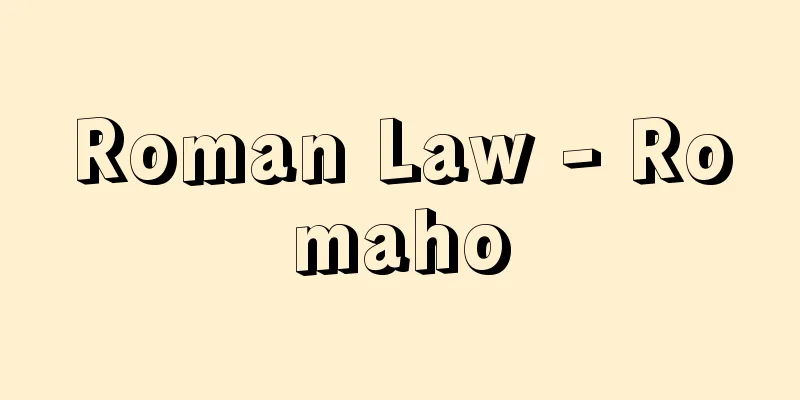Roman Law - Romaho

|
Law developed over a period of about 1,200 years, from the founding of Rome to the compilation of a legal code by Emperor Justinian (reigned 527-565) in the 6th century. Because of its immeasurable influence on later generations, the Roman law that was inherited is sometimes called Medieval Roman law or Early Modern Roman law, in contrast to ancient Roman law. The original ancient Roman law is usually explained in three periods. [Atsushi Sato] First PeriodFrom the foundation of Rome to 202 BC, as typified by the Twelve Tables, it was the law of a small city-state that regulated the agricultural life of a small family (couple and children) centered around the father of the household. Therefore, the law was structured around the strong power of the father, patria patestas. There were strict procedures for legal acts such as the transfer of certain important assets that supported family life, such as land, slaves, and cattle, and for lawsuits, and if these procedures were not followed, the law would not be valid and the purpose would not be achieved. These laws were called civil law (ius civile), and were personal laws that were applied (protected) only to Roman citizens by the priests, and non-Roman citizens were given legal protection only when they were granted the right to trade and marry. As an ancient law that regulated the narrow urban life, there are many mechanisms in common with the laws of other ancient city-states, such as hierarchical criminal law, taglio, and debt slavery. [Atsushi Sato] Second PeriodThis period was from 201 BC to 235 AD, and was the period of preclassical and classical law. After Rome won the Second Punic War and its territory expanded dramatically, it had to deal with legal issues between Romans and foreigners, and between foreigners themselves. In order to deal with these issues, a praetor was appointed to deal with foreigners, and a universal civil law (ius gentium) was formed, which was flexible and applicable to foreigners, with a focus on transactional law, and revised, abolished, and supplemented the civil law of the first period. The praetor, with the assistance of secular legal scholars, issued notices, prepared a procedure manual for litigation, and actively provided relief through litigation when protection was required. In this way, the distinction between ownership and possession emerged, the laws of credit and debt relationships diversified, and consensual contracts (sales, rentals, partnerships, and mandates) that were established by a mere expression of will appeared. This was a phenomenon not seen in other nations until the formation of modern law. The diversification of law was almost achieved by the first half of this second period. In the Principatus period, the republic maintained a republican political system at first, but from the time of Emperor Hadrian (reigned 117-128), the tendency towards sole rule by the head of state became evident, and a head of state bureaucracy was created. The head of state proposed resolutions in the senate, and eventually decrees were issued. In litigation, in addition to the traditional formal lawsuits, special litigation procedures based on the power of the head of state appeared. These legal activities were supported by legal scholars. Legal scholars formed schools such as the Sabinian and Proclusian schools, and worked not only for the head of state but also to provide legal advice to ordinary citizens, but gradually specific legal scholars were selected to form an advisory council as advisors to the head of state. The advisory council provided answers to specific legal questions, and after Emperor Hadrian, the answers of legal scholars who were given the imperial right to answer were considered legally binding, contributing to the creation of law. Many legal schools were established and legal studies flourished. Influenced by Hellenism, law was refined and precise theories were developed. Some people compiled existing laws and added annotations to them, while others wrote Institutiones (Institutional Studies) for beginners and taught them. Of the 40 legal scholars cited in Emperor Justinian's legal code, Digesta, 35 were from this period. Unlike modern law, which is self-contained, systematic, and abstract, such advanced theories were very concrete and took the form of legal solutions to individual cases. [Atsushi Sato] Third PeriodFrom 236 to the compilation of the Code by Emperor Justinian. Emperor Diocletian (reigned 284-305) divided the empire into two halves (East and West) (395), appointed a co-emperor and a co-emperor to each side, established an autocratic government called Dominatus, and created a centralized bureaucratic state. Instead of legal creation through jurisprudence, the imperial laws (constitutio) issued by the emperor became the almost sole source of law. The bearers of law became mere literate bureaucrats, who could not understand the intricate legal techniques of classical law, and sought a code as a basis for legal practice. The citation law and the compilation of the Theodosian Code were a response to this. Law underwent some transformation in both the West and the East due to the influence of indigenous culture. The influence of Christianity cannot be ignored either. In the first half of the 6th century, Emperor Justinian, based on the idea of restoring the Roman Empire, thoroughly examined all sources of Roman law and compiled a code of law that should become current law. This code of law was passed down through the Bologna School of Commentaries in the Middle Ages, the Humanist School, the Enlightenment school of natural law, and the Pandecten School of jurisprudence in the early modern period, and had a decisive influence as a legal resource on the formation of modern European law. [Atsushi Sato] "Roman Law" by Funada Kyoji, 5 volumes (1968-72, Iwanami Shoten)" ▽ "Roman Law" by Harada Keikichi (1949, Yuhikaku)" ▽ "Principles of Roman Law" by Harada Keikichi (1967, Shimizu Kobundo Shobo)" ▽ "Roman Law and Society" by Yoshino Satoru (1976, Kondo Publishing)" ▽ "Outline of Roman Law" by Shibata Mitsuzo (1979, Genbunsha)" ▽ "History of Roman Law I" by Sato Atsushi (1982, Keibundo) [Reference] |Source: Shogakukan Encyclopedia Nipponica About Encyclopedia Nipponica Information | Legend |
|
ローマ建国から6世紀のユスティニアヌス帝(在位527~565)による法典編纂(へんさん)までの約1200年にわたって展開された法。後世に計り知れないほどの大きな影響を与えたことから、継受されたローマ法を古代のローマ法と対比して、中世ローマ法、近世ローマ法などとよぶ用い方もある。古代の本来のローマ法は普通三期に分けて説明される。 [佐藤篤士] 第一期ローマ建国から紀元前202年までで、十二表法に典型的に表れているように、家父を中心とした小家族(夫婦と子供)の農業生活を規律する狭い都市国家の法であった。したがって、法は家父の強力な権力patria patestasを中心として構成されている。土地や奴隷や牛馬など、家族生活を支える特定の重要な財産の譲渡のような法律行為を行うにも、また訴訟を行うにも定まった厳格な方式があり、それを守らないと効力が認められず、目的を達することができなかった。これらの法は市民法(ユス・キウィレius civile)とよばれ、神官によってローマ市民にだけ適用される(保護を受ける)属人法であり、ローマ市民以外の人々にはとくに取引権、通婚権を認めた場合にだけ法的保護を与えるものであった。狭い都市生活を規律する古代の法として、階級刑法やタリオ、債務奴隷制など他の古代都市国家の法と共通する仕組みが多くみられる。 [佐藤篤士] 第二期紀元前201年から後235年までで、前古典法と古典法の時代である。ローマが第二次ポエニ戦争で勝利を得てその支配領域が飛躍的に拡大し、その結果ローマ人と外国人、外国人相互間の法律問題に対処しなければならなくなった。これらの諸問題を処理するために外人係法務官を設置し、取引法を中心として、方式にこだわらない柔軟な、外国人にも適用される万民法(ユス・ゲンティウムius gentium)が形成され、第一期の市民法を改廃・補充した。法務官は世俗の法学者を顧問として告示を発し、訴訟のための方式書をつくって保護すべき場合には訴訟を通じて積極的に救済した。このようにして、所有と占有との区別が現れ、債権・債務関係の法が多様化して、単なる意思表示だけで成立する諾成契約(売買、賃約、組合、委任)が現れるに至った。これは他の民族では近代法の形成までみられなかった現象である。法の多様化はこの第二期前半までにほぼ成し遂げられた。 元首政期Principatusに入ると、初めのうちは共和的政治体制を維持していたが、ハドリアヌス帝(在位117~128)のころから元首の一人支配の傾向が色濃くなり、元首の官僚制がつくられるようになった。元首の提案による元老院議決がなされ、やがて勅令が発せられるようになる。訴訟も、従来の方式書訴訟とともに元首の権力に基づく特別訴訟手続が現れた。このような法活動を支えたのは法学者であった。法学者たちは、サビーヌス学派とプロクルス学派というように学派を形成し、元首のためばかりでなく、一般市民の法律相談にも活動したが、しだいに特定の法学者が選ばれて元首の顧問として顧問会を形成した。顧問会は具体的な法律問題に回答を与え、ハドリアヌス帝以降、勅許回答権を与えられた法学者の回答が法的拘束力をもつものとされ、法創造に寄与した。法学校も数多く開設されて法学は隆盛を極め、ヘレニズムの影響を受けて、法を洗練し緻密(ちみつ)な理論を展開した。ある者は従来の法律を編集してこれに注釈を加え、また、ある者は初学者のために『法学提要』Institutionesを著して、これを教授した。ユスティニアヌス帝の法典『学説彙纂(いさん)』Digestaに引用された40人の法学者のうち、この時期の法学者は35人にも上っている。このような高度の理論も、自己完結的、体系的、抽象的な近代法とは異なって、非常に具体的であり、個々の事件に対する法的解決という方式をとっている。 [佐藤篤士] 第三期236年からユスティニアヌス帝の法典編纂まで。ディオクレティアヌス帝(在位284~305)は帝国を東西に二分し(395)、それぞれに正帝と副帝を置き、専主政Dominatusを確立して中央集権的官僚国家をつくりあげた。法学による法創造にかわって皇帝の発する勅法constitutioがほとんど唯一の法源となった。法の担い手は単に読み書きのできる官僚となり、彼らは古典法の緻密(ちみつ)な法技術を理解することができず、法運用のよりどころとして法典を求めた。引用法や『テオドシウス法典』の編纂はこれにこたえたものであった。法は西部でも東部でも土着文化の影響を受けて多少の変容を遂げるに至った。また、キリスト教の影響も無視できない。6世紀前半ユスティニアヌス帝は、ローマ帝国復活の理念に基づき、すべてのローマ法源を精査し、現行法とすべき法の編纂を行った。これが中世のボローニャの注釈学派や、人文学派、近世の啓蒙(けいもう)期自然法学、パンデクテン法学などを通じて受け継がれ、ヨーロッパの近代法の形成に法素材として決定的影響を与えた。 [佐藤篤士] 『船田享二著『ローマ法』全5巻(1968~72・岩波書店)』▽『原田慶吉著『ローマ法』(1949・有斐閣)』▽『原田慶吉著『ローマ法の原理』(1967・清水弘文堂書房)』▽『吉野悟著『ローマ法とその社会』(1976・近藤出版社)』▽『柴田光蔵著『ローマ法概説』(1979・玄文社)』▽『佐藤篤士著『ローマ法史Ⅰ』(1982・敬文堂)』 [参照項目] |出典 小学館 日本大百科全書(ニッポニカ)日本大百科全書(ニッポニカ)について 情報 | 凡例 |
<<: Corpus Iuris Civilis (Latin)
>>: Pros Romaious; The Letter to the Romans
Recommend
EXIM
…Abbreviated as EXIM, or EIB, it is a government-...
ventral side
…In both fish and tetrapods, the muscular region ...
Ectomycorrhizae - Gaikinkon
Mycorrhizae are fungi that grow mainly in the tiss...
Gnathostoma spinigerum
… [Shomei Kojima]. … *Some of the terminology tha...
Engyō - Engyō
Year of death: 29 March 852 Year of birth: Enryaku...
Kenya [Mountain] - Kenya
An extinct volcano located in central Kenya, East ...
Republic of South Maluku
Following the Hague Round Table Conference in Dece...
imago
… [Semantics] It comes from the Latin imago, whic...
Sakura Sogoro
Date of birth and death unknown. A representative...
Akita Castle
An ancient castle fort from the Nara to Heian peri...
Administrative legislation - Gyosei Rippo
The executive branch makes general and abstract pr...
Otsukushiyama
...It is made up of rhyolite, dacite, and pyroxen...
Ran'isha
A political association with a special mission ch...
Fluorescent lamp
A discharge lamp that converts ultraviolet light ...
Long-nosed planthopper
...Many of the species in this family have heads ...









